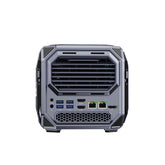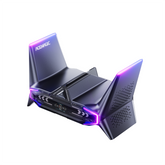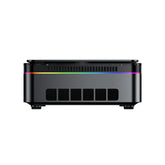Intel Core Ultra 7 vs i7: Which Processor Is Right for You?

With the continuous advancement of technology, processors have become the most critical components in personal computers, laptops, and high-performance computing devices. Recently, Intel introduced the next-generation Intel Core Ultra 7 processor, while the classic i7 series remains a popular choice among consumers and professionals. So, when faced with these two seemingly different yet overlapping processors, which one should users choose?
The Intel Core Ultra 7, as Intel's new high-end processor, showcases the latest in architectural design, performance enhancements, and energy efficiency. Meanwhile, the i7 series, honed over years, serves as a benchmark in the mid-to-high-end market. Many users might wonder: can the Intel Core Ultra 7 truly replace the i7's status? Or, in what ways does it surpass the i7, and in which scenarios might it not perform better?
In this article, we will dive deep into the comparison of the Intel Core Ultra 7 vs i7, exploring their performance differences, strengths and weaknesses, and their suitability for various use cases. We will not only focus on individual processor models but also take a broader look at the overall comparison of Intel Core Ultra 7 vs Intel Core i7, helping you make the best choice for your needs.
Processor Specifications Comparison
In this section, we will compare the key specifications of the Intel Core Ultra 7 165H, Intel Core i7-1185G7, and Intel Core i7-1165G7 processors. These three processors were chosen because they represent Intel's mobile processors at different stages of development, spanning the latest Intel Core Ultra series and the iconic i7 series. By analyzing these fundamental specifications, we can gain insight into their differences in core configurations, performance improvements, and thermal efficiency, providing a baseline for subsequent performance evaluations.
Below is a comparison of the specifications for the Intel Core Ultra 7 165H, Intel i7-1185G7, and Intel i7-1165G7:
| Spec | Intel Core Ultra 7 165H | Intel Core i7-1185G7 | Intel Core i7-1165G7 |
|---|---|---|---|
| Cores | 16 (6 performance cores + 8 efficiency cores) | 4 | |
| Threads | 22 | 8 | |
| Max Turbo Frequency | 5.0 GHz | 4.80 GHz | 4.70 GHz |
| Base Frequency | 1.4 GHz (performance cores) | 3.0 GHz | 2.8 GHz |
| Cache | 24 MB Smart Cache | 12 MB Smart Cache | |
| TDP | 28W (base) / 115W (max) | 12W to 28W (adjustable) | |
| Supported Technologies | Hyper-Threading, Turbo Boost, AI Turbo, Xe Graphics, PCIe 5.0 | Hyper-Threading, Turbo Boost, Iris Xe Graphics, Thunderbolt 4 | |
| Integrated Graphics | Intel Arc™ Graphics (8 cores) | Intel Iris Xe Graphics (96 execution units) | |
| Max Memory Support | 96 GB (LPDDR5 / DDR5) | 64 GB (LPDDR4x/DDR4) | |
| Graphics Support | Up to 8K resolution, ray tracing, AV1 decoding | 4K resolution, DirectX 12.1 | |
| AI Acceleration Support | Intel AI Boost, AI acceleration | Intel Deep Learning Boost | |
From the table, it’s clear that the Intel Core Ultra 7 165H significantly outshines the i7-1185G7 and i7-1165G7 in terms of core count and thread count, with a notable 16-core (6 performance + 8 efficiency) design that allows for superior parallel processing. Additionally, the Ultra 7’s maximum turbo frequency hits 5.0 GHz, surpassing the i7-1185G7’s 4.8 GHz and the i7-1165G7’s 4.7 GHz. This boost in clock speed makes a significant difference in multitasking and high-load operations.
The Ultra 7 has a base frequency of 1.4 GHz for its performance cores, but it can dynamically scale up to a 5.0 GHz turbo speed. This ensures strong single-threaded performance for complex tasks. While the i7-1185G7 and i7-1165G7 offer close turbo frequencies, the Ultra 7’s frequency advantage makes it more capable under demanding workloads.
In terms of cache, the Intel Core Ultra 7 features 24 MB of Intel Smart Cache, double the 12 MB found in both i7 models. This difference allows the Ultra 7 to handle larger data sets more efficiently, which can be especially beneficial for heavy computational tasks or processing large files.
Overall, the Intel Core Ultra 7 stands out with its advanced processor architecture, higher core counts, better clock speeds, and superior graphics capabilities, making it an excellent choice for high-performance professional tasks and multitasking environments. Meanwhile, the i7 series continues to shine in terms of power efficiency and widespread adoption, making it a reliable choice for many mid-to-high-end devices.
Recommended Reading: DDR4 vs DDR5 RAM: Comprehensive Comparison Guide
Performance Enhancements

The Intel Core Ultra 7 boasts significant technological innovations and improvements compared to the traditional i7 series, particularly in areas such as AI acceleration, graphics processing, and thermal management. Most notably, the built-in AI capabilities of the Ultra 7, specifically through Intel's AI Turbo technology, enable efficient completion of AI tasks while being more economical in terms of power consumption compared to traditional CPUs. Its deeply integrated AI acceleration functionality allows the Ultra 7 to demonstrate exceptional computing power when processing big data, machine learning, and intelligent applications, setting it apart in the intel core ultra 7 vs i7 comparison.
Moreover, the Ultra 7 introduces the Intel® Arc™ integrated graphics, a technological breakthrough that significantly surpasses the i7 series in terms of graphics performance. The Arc™ graphics not only support real-time ray tracing but also provide more powerful graphics processing capabilities. For graphics-intensive tasks such as gaming, video editing, and 3D rendering, the Ultra 7 exhibits a strong advantage over the intel core i7 vs ultra 7. Although the i7 series is equipped with Intel® Iris® Xe graphics, which can handle basic graphics tasks, it falls short in high-end graphics applications and content creation.
In terms of cooling and energy efficiency, the innovative technologies in the Ultra 7 enable it to maintain efficient operation under prolonged high-load conditions. Even when processing complex tasks, the Ultra 7 can deliver sustained high performance, whereas the i7 may face power consumption and thermal control limitations in similar scenarios. Overall, while the i7 remains a powerful processor, the Intel Core Ultra 7, with its advanced technologies, takes performance to a new level in AI processing and graphics capabilities. It is suitable for users who require robust computing and graphics processing, particularly those who demand higher efficiency and creative capabilities, making it a clear winner in the intel core ultra 7 vs i7 and comparisons.
Recommended Reading: AMD Ryzen 7 vs Intel Core i7: A Comprehensive Comparison
Intel Core Ultra 7 vs i7: Single-Core Performance Differences
When comparing the single-core performance of the Intel Core Ultra 7 and the i7 series, we take the Intel Core Ultra 7 165H and the Intel Core i7-1185G7 as examples. According to benchmark tests, the Intel Core Ultra 7 165H achieves a single-core score of 174 Pts, significantly higher than the i7-1185G7's 136 Pts, indicating that the Ultra series has a clear advantage in single-core performance.
| Processor Model | Single-Core Score (UserBenchmark) |
|---|---|
| Intel Core Ultra 7 165H | 174 Pts |
| Intel Core i7-1185G7 | 136 Pts |
So, why does the Intel Core Ultra 7 165H have a higher single-core score? Firstly, the Intel Core Ultra 7 165H utilizes Intel's new Meteor Lake architecture, featuring 6 high-performance cores and 8 high-efficiency cores. It can achieve higher single-core performance through its 5.0 GHz Turbo frequency under high loads. In contrast, while the Intel Core i7-1185G7 also belongs to the Tiger Lake architecture, its maximum Turbo frequency is 4.8 GHz. Therefore, under the same workload, the Ultra 7's frequency and architectural advantages allow it to excel in single-core tasks, showcasing its superiority in the intel core ultra 7 vs i7 comparison.
The design of the Intel Core Ultra 7 not only enhances overall performance but also specifically optimizes single-core performance, enabling it to perform more exceptionally in tasks that require high clock speeds and quick responsiveness. This explains why the Ultra 7 can surpass the i7 series in user benchmarks, providing a smoother user experience and cementing its position in the intel core i7 vs ultra 7 debate.
Intel Core Ultra 7 vs i7: Price Comparison
The market positioning and pricing strategies of the Intel Core Ultra 7 and i7 have significant differences, making them suitable for users with varying needs and budgets. As Intel's new generation of high-end processors, the Intel Core Ultra 7 is positioned in the high-performance market, designed specifically for users who require powerful computing capabilities and advanced technologies. Its price is typically higher, with the Intel Core Ultra 7 165H having a recommended retail price of $460. Although this price point reflects its advanced AI acceleration capabilities and stronger graphics performance, it also means that it primarily targets the high-end market, suitable for professional users or gaming enthusiasts who demand the highest performance.
In comparison, i7 processors (such as the i7-1185G7 and i7-1165G7) are more widely used in mid-to-high-end consumer-grade devices, with prices usually ranging from 300 to 400. While the i7 still provides excellent performance and is suitable for most office, creative, and entertainment tasks, its positioning focuses more on cost-effectiveness, making it ideal for users who want to obtain high efficiency at a lower budget. Although the i7 performs exceptionally well in daily use, its capabilities in AI acceleration and graphics processing are not as advanced as the Ultra 7. Therefore, in situations that require higher computational demands or professional graphics performance, the i7 may not be as suitable as the Ultra 7.
Intel Core Ultra 7 vs i7 Thermal Efficiency
Power consumption and heat dissipation management are crucial factors in a processor's performance. Although both the Intel Core Ultra 7 and i7 are high-performance processors, they differ in their thermal efficiency and power management strategies, especially under heavy load conditions.
Power Consumption and Heat Dissipation of Intel Core Ultra 7: The Intel Core Ultra 7 utilizes the Intel 4 process and a new architecture design, featuring more performance cores and efficient cores. Its maximum Turbo power consumption can reach 115W, while the base power consumption is 28W. This means that under high-load conditions, the Ultra 7 can provide extremely strong performance output, but it also requires a more robust cooling system to maintain stable operation. In thin and light laptops or Mini PCs, if there is no proper cooling design, the Ultra 7 may face throttling issues due to high temperatures, affecting performance stability.
ACEMAGIC Intel Ultra 7 F2A Mini PC

- The Acemagic F2A 155H Mini PC features an Intel® Core™ Ultra 7 155H processor with 16 cores and 22 threads, delivering powerful performance for AI, multimedia, and general tasks. With Intel® Arc™ graphics, 32GB DDR5 RAM, and fast 1TB PCIe 4.0 SSD storage, it offers high efficiency and stunning visuals. Ideal for demanding applications, it supports WiFi 7 and 4K video output.
However, through improved thermal management technologies, such as Dynamic Performance Management and the low-power design of efficient cores, the Intel Core Ultra 7 can still maintain low power consumption under general workloads. For example, in daily office work and web browsing tasks, the low-efficiency cores of the Ultra 7 can effectively reduce power consumption and maintain a good energy efficiency ratio.
Power Consumption and Heat Dissipation of Intel Core i7: In comparison, i7 processors (such as the i7-1185G7 and i7-1165G7) use the 10nm SuperFin process, with a more flexible TDP range, typically ranging from 12W to 28W, and can reach lower power consumption values under high load (e.g., the maximum power consumption of the i7-1185G7 is 28W). This makes the i7 excellent in power management, especially suitable for thin and light laptops and devices with low power requirements. Under high-load conditions, the thermal effects of the i7 are milder than the Ultra 7. Although its performance is relatively inferior, it is more stable during long-term operation and has lower cooling requirements.
Differences in Practical Applications:
- Thin and Light Laptops: For users of thin and light laptops, the low-power characteristics of the i7 make it an ideal choice, especially when not relying on external cooling systems. The i7 can run multitasking at low power consumption without significantly affecting battery life.
- Mini PCs and High-Performance Devices: If you are using a Mini PC or a device that requires long-term high-load computing, the Intel Core Ultra 7 may be more suitable. It can provide stronger performance support but requires a more powerful cooling system to ensure stable performance output.
Intel Core Ultra 7 vs i7 - Which One is More Suitable for You?
When choosing between the Intel Core Ultra 7 and i7, the key factors are your needs and budget. Both have their advantages and disadvantages and are suitable for different types of users.

The Intel Core Ultra 7 is particularly suitable for professional users who require high-performance computing and graphics processing, thanks to its powerful AI acceleration, advanced graphics performance (integrated Intel® Arc™ graphics card), and higher single-core and multi-core performance. For example, game developers, video editors, 3D modelers, and technical personnel engaged in AI tasks can benefit from the Ultra 7's technological advantages, which provide them with more efficient workflows and faster processing speeds. Moreover, the Ultra 7's innovative technologies can effectively handle temperature and power consumption management under long-term load, making it particularly suitable for high-intensity usage scenarios.
On the other hand, the Intel Core i7 is a highly cost-effective choice, widely used in mid-to-high-end laptops and desktops, suitable for most daily usage scenarios, including office work, multitasking, and light creation. The i7 processors have relatively strong performance and can handle most application requirements, especially when the budget is limited. The i7 can still provide quite good computing power and graphics performance. For users who need efficient daily office work, multimedia consumption, or occasional gaming, the i7 is a good choice.
Recommendations:
- Choose Intel Core Ultra 7: If you engage in graphics-intensive work (such as gaming, video editing, or 3D rendering), require powerful AI processing capabilities, or want to maintain high performance under long-term heavy load, the Intel Core Ultra 7 would be a more suitable choice.
- Choose Intel Core i7: If you primarily perform daily office work, multitasking, light creation, or entertainment activities, and have a limited budget, the Intel Core i7 is still a very powerful choice.
In the intel core ultra 7 vs i7 and intel core i7 vs ultra 7 comparisons, it is clear that both processor series have their strengths and target different user groups. The Ultra 7 is designed for users with demanding performance requirements, while the i7 caters to a wider range of users who prioritize cost-effectiveness and versatility. By understanding your specific needs, usage scenarios, and budget constraints, you can make an informed decision between the Intel Core Ultra 7 and i7 processors, ensuring that you choose the one that best aligns with your requirements and delivers the optimal computing experience for your needs.
FAQs
1. What is the difference between Intel Core Ultra 7 and i7?
The Intel Core Ultra 7 (e.g., 165H) is a newer, high-performance processor designed with advanced features like AI Turbo, Intel Arc™ graphics, and enhanced thermal management. It features a hybrid architecture with Performance-cores and Efficient-cores, making it better suited for multitasking and AI-driven tasks. In contrast, the i7 (e.g., 1185G7, 1165G7) is an older model with fewer cores and lacks the specialized AI capabilities and advanced graphics found in the Ultra 7. Ultra 7 offers superior single-core and multi-core performance, particularly for tasks like gaming and creative workloads.
2. How does Intel Core Ultra 7 compare to i7 in terms of single-core performance?
Intel Core Ultra 7 significantly outperforms the i7 in single-core tasks. Based on benchmark data, the Ultra 7 scores 174 points in single-core performance (28% faster than the i7-1185G7, which scores 136 points). This results in better performance for day-to-day activities like web browsing, office tasks, and gaming. The Ultra 7's architecture allows for higher turbo boost frequencies, delivering enhanced single-core efficiency.
3. Is Intel Core Ultra 7 better for gaming than i7?
Yes, the Intel Core Ultra 7 is a better choice for gaming, thanks to its advanced Intel Arc™ graphics, which provide ray tracing and improved graphics processing. While the i7-1185G7 comes with integrated Intel Iris® Xe Graphics, it lacks the dedicated GPU capabilities of the Ultra 7, which significantly enhances gaming performance. Ultra 7 also supports higher resolutions and frame rates, offering a better gaming experience overall.
4. Does the Intel Core Ultra 7 have better power efficiency than the i7?
The Intel Core Ultra 7 is designed with better power efficiency, especially under heavy workloads. It features a lower base power consumption compared to the i7 but can scale up its performance when needed. With advanced thermal and power management technologies, the Ultra 7 can maintain high performance without generating excessive heat, making it suitable for thin laptops and mini PCs. The i7, while efficient, lacks the same level of power scaling and efficiency optimizations.
5. What are the thermal differences between Intel Core Ultra 7 and i7?
The Intel Core Ultra 7 has improved thermal efficiency, thanks to its hybrid architecture and AI-driven thermal management. This allows it to handle high loads without excessive heat generation, making it ideal for devices where space and cooling solutions are limited. The i7, while capable of handling heat well, doesn't have the same level of optimization as the Ultra 7. Users may notice better sustained performance in Ultra 7-equipped devices, especially in gaming or content creation scenarios.
6. Which processor is more suitable for AI tasks: Intel Core Ultra 7 or i7?
The Intel Core Ultra 7 is far more suited for AI-driven tasks than the i7, as it features Intel's AI Turbo and deep learning capabilities. This enables faster and more efficient execution of machine learning and AI workloads. The i7 lacks these advanced AI-specific features, meaning it won’t perform as well in tasks such as AI image processing or real-time AI video enhancements. If you're working with AI tools or require high-level machine learning performance, the Ultra 7 is the better choice.
References and Further Reading
[1] UserBenchmark: Intel Core i7-1185G7 vs Ultra 7 165H [Cited January 20, 2025] Available at: Link
[2] Intel® Core™ Ultra 7 Prozessor 165H - Intel [Cited January 20, 2025] Available at: Link
[3] Intel® Core™ i7-1185G7 Processor - Intel [Cited January 20, 2025] Available at: Link
[4] Intel® Core™ i7-1165G7 Processor - Intel [Cited January 20, 2025] Available at: Link
[5] Ultra 7 165H vs i7-1165G7 (12-Benchmark Showdown) [Cited January 20, 2025] Available at: Link







Leave a comment
Please note, comments need to be approved before they are published.